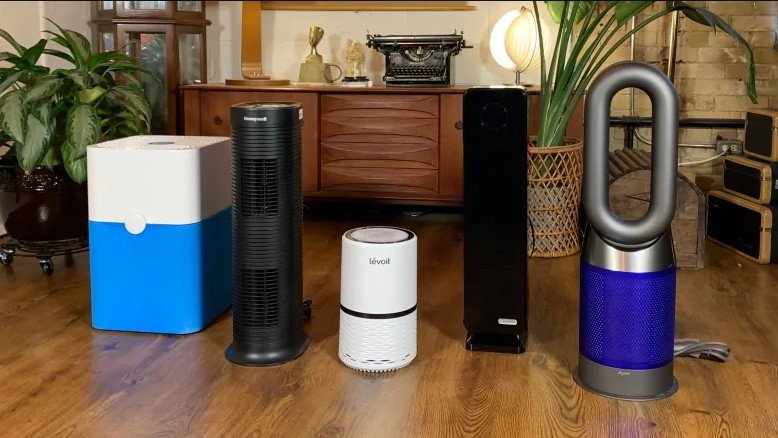We reside in an era where the act of breathing outdoors, especially within the confines of our homes, has become perilous. The indoor air remains stagnant, lacking in purification. It becomes saturated with carbon dioxide, bacteria, noxious emanations emitted by furniture, construction materials, aging textiles, and particulate matter. Even the simple act of opening a window invites the infiltration of exhaust fumes from vehicles and emissions emanating from neighboring industrial establishments. To safeguard ourselves from this daily poisoning that accelerates the erosion of our well-being and vitality, it is prudent to select a suitable air purifier.
Numerous options abound, yet the pivotal factor lies in avoiding bewilderment and discerning one’s ultimate objective. It is essential to select an air purifier equipped with the requisite features. Let us delve into the various purification technologies available today and ascertain the most efficacious one.
Air purifiers that use air filtration
Mechanical filtration stands as the initial and most prevalent technology employed for air purification. Given the diverse array of airborne particles, ranging from animal and human hair to minute dust particles and volatile chemical compounds, various filters have been devised.
Pre-filters, designed to address coarse contaminants, diligently cleanse the air of hair, coarse dust, and even wisps of pollen. Typically composed of a plastic grid or fine foam rubber, these pre-filters efficiently trap sizable particles drawn in by the fan. Their presence reduces the frequency of replacing the finer filters. To ensure optimal performance of the air purifier, it is advisable to clean the pre-filter every two weeks to a month, either by employing a vacuum cleaner or rinsing it with water to dislodge accumulated debris.
Following the pre-filters, finer filters such as electrostatic filters, HEPA filters, and nano-filters, take center stage. These filters excel in capturing minuscule dust particles, thereby accomplishing their primary mission of eliminating the most hazardous fine dust that poses great harm to individuals. For allergy sufferers, asthmatics, and young children, only the most potent HEPA filters guarantee air quality that is tolerable.
Charcoal filters prove instrumental in eradicating unpleasant odors, tobacco smoke, and chemical compounds by absorbing these volatile substances into their micro-porous surface.
Although many air purifiers equipped with HEPA filters exhibit exceptional efficacy, purifying up to 99.8% of the air, they possess two drawbacks:
- The cost associated with replacing the filters as they gradually accumulate debris.
- The filtered air becomes stagnant and devoid of vitality.
Therefore, it is advisable to select air purifier models that incorporate pre-filters, prolonging the lifespan of the HEPA filter, and feature an ionization function to fully restore the natural properties of purified air. Ionized air not only poses no harm but, on the contrary, offers tremendous health benefits, reminiscent of the invigorating ambiance experienced in forests, near water bodies, and amidst majestic mountains.
Read the article Best Air Purifier for Pets – https://verywellhome.com/best-air-purifier-for-pets
Air purifiers that use air filtration
Mechanical filtration stands as the primary and most prevalent technology for air purification. Given the contamination of the air with particles of varying sizes, ranging from animal hair and human hair to the finest dust and volatile chemical compounds, a range of filters is available.
Pre-filters, designed to address the removal of coarse contaminants, diligently cleanse the air of hair, coarse dust, and even poplar fuzz. Typically composed of a grid of plastic or fine foam rubber, these pre-filters effectively trap all large particles drawn in by the fan. Incorporating pre-filters reduces the frequency of replacing the finer filters. It is recommended to clean the pre-filter approximately every 2 weeks to a month using a vacuum cleaner or by rinsing it with water to free it from accumulated dirt and ensure the air cleaner operates at a high quality.
The pre-filters are typically followed by finer filters, such as electrostatic filters, HEPA filters, and nano-filters, which possess the capability to capture even the finest dust particles. These filters excel in their primary task: the removal of the most hazardous fine dust, which poses significant harm to individuals. Among these, the most effective are HEPA filters, which provide air quality that is acceptable for allergy sufferers, asthmatics, and young children.
Charcoal filters effectively eliminate unpleasant odors, tobacco smoke, and chemicals by absorbing these volatile substances into the micro pores on the surface of the charcoal.
While many air purifiers equipped with HEPA filters exhibit high effectiveness, capable of cleaning 99.8% of the air, they come with two disadvantages:
- The cost associated with replacing the filters as they become clogged over time.
- The filtered air lacks vitality.
Therefore, we recommend selecting air purifier models that feature pre-filters to prolong the lifespan of the HEPA filter, as well as an ionization function that fully restores the natural properties of the purified air. Ionized air not only lacks harmful effects but, on the contrary, offers significant health benefits, reminiscent of the invigorating atmosphere found in forests, near ponds, and amidst mountains.
Learn more about air purifiers – https://myintelligenthouse.com/best-air-purifier-for-weed-smoke/
Ionizing air purifiers
Ionizers can possess various filters or operate solely through ionization. They cleanse the air through the application of an electric charge. A surge of high voltage is channeled into slender metallic needles, each with a tip diameter measuring 5 to 10 μm, permitting the graceful flow of electrons. Oxygen molecules intertwine with these electrons, acquiring a negative charge and transforming into negative ions. These negative ions, being natural purifiers of the air, bestow upon it the lightness and freshness reminiscent of countryside breezes.
In nature, ions manifest through the radiant touch of ultraviolet sunlight and the majestic symphony of thunderstorms. As these ions encounter pollutants suspended in space, their electrical charge entices the formation of newfound particles, gradually augmenting in size until gravity beckons their descent. In this harmonious process, the air undergoes a natural purification, ridding itself of dust, odors, bacteria, and viruses. The efficacy of ionizers in this cleansing endeavor ranks among the most remarkable.
Moreover, ionization casts a benevolent influence upon human well-being and health. It finds utility in promoting wellness and thwarting various ailments, diminishing fatigue, enhancing productivity and immunity, purging aerosol pollution, allergens, and microorganisms, neutralizing the deleterious impact of computers, televisions, and office machinery, revitalizing the biological vitality of air coursing through chambers via air conditioners, filters, and ducts, all the while establishing an atmosphere of utmost comfort.
When selecting an ionizing air purifier, it is crucial to consider yet another pivotal aspect: the device should emit a precisely defined quantity of ions, as stipulated by the American Public Health Association (APHA). This vital information ought to be discerned within the specifications of the chosen device, warranting diligent scrutiny. The optimal level of ionization typically ranges from 400 to 50,000 ions per cubic centimeter of air, ensuring a balanced and revitalizing ambiance.
|
Number of ions in 1 cm3 of air (N+, N-) |
Positive ions |
Negative ions |
|
The minimum required |
400 |
600 |
|
Optimal |
1500-3000 |
3000-5000 |
|
Maximum allowable |
50000 |
50000 |
Air washers
Hydrofiltration technology is harnessed by air washers to purify the air. A gentle current of air traverses a delicate veil of water, akin to a serene water bath, gracefully eradicating all contaminants suspended within. Impurities are delicately coaxed from the air, relinquishing their hold as they succumb to the weighty embrace of the water, settling gracefully into the tray. In turn, the air emerges purified, suffused with gentle humidity, graciously permeating the room.
This is why air washers have garnered immense popularity among discerning individuals. They not only cleanse the air but also bestow it with the gift of moisture, imbuing a sense of well-being while bolstering the body’s natural defenses. The introduction of humidity ensures supple skin and lustrous hair, easing respiration by preserving moisture in the nasopharynx, thus alleviating and preempting the discomfort of common colds.
In addition, air washers may feature supplementary functions such as ionization and photocatalysis, presenting a comprehensive climate complex encompassing purification, humidification, and ionization. The allure of air washers lies in their lack of removable filters; however, they do require attentive care. Regular replenishment and renewal of water are imperative to prevent stagnation and the possibility of sourness. Therefore, when acquiring such a humidifier-cleanser, it is essential to remember to tend to its needs promptly, an endeavor easily accomplished due to its inherent simplicity.
Air purifiers – ozonators
Air purifiers – ozonators cleanse the air by harnessing the power of active oxygen, known as ozone. Ozoneation is a timeless, natural purification process that has graced our planet for centuries. In the embrace of nature, ozone arises after a tempestuous thunderstorm, imbuing the air with a distinct, invigorating freshness. Being an inherently transient gas, ozone swiftly decomposes upon encountering other substances, thus forming the bedrock of this purification technology.
When ozone encounters a pollutant molecule, a chemical reaction ensues, leading to the creation of simpler, innocuous compounds. These often manifest as derivatives of carbon dioxide, oxygen, and water. Furthermore, ozonators expeditiously dismantle lingering odors (from pets, post-renovation scents, culinary fragrances, etc.) and combat tobacco smoke, vanquishing viruses, bacteria, mold, dust mites, and other microorganisms.
Ozoneation exhibits remarkable efficacy, obviating the need for filter changes, water replacements, and the like, as all contaminants decay into nothingness, requiring naught but a well-ventilated room. However, it is imperative to remember that while ozone can combat odors, chemicals, and microbes with unwavering resolve, it remains powerless against mechanical contaminants such as dust. Thus, it would be optimal for an air ozonator to encompass additional dust filters, enabling a comprehensive solution to the quandary. You may acquire such household ozonators from our esteemed online emporium.
Ozonating machines offer two distinct operational modes:
- Normal mode, emitting ozone within the natural concentration range (0.005 – 0.03 mg/m3), bestowing a stimulating effect upon the human body. It augments immunity, fortifies resilience against toxic substances, heightens hemoglobin levels in the blood, and normalizes blood pressure, akin to basking in the invigorating embrace of the open air.
- Intensified mode, intended for rapid and efficacious purification. However, this mode should solely be employed in unoccupied spaces, as the concentration required for expeditious eradication of odors and microbes surpasses established safety standards. (Single ozone concentration in the atmospheric air of settlements: 0.16 mg/cub. m; Average daily concentration: 0.03 mg/cub. m). Inhaling such ozonized air is deemed unsafe.
After utilizing an ozonator, it is essential to ventilate the room or allow 1-2 hours for the ozone to dissipate. Modern models feature timers for the intensified mode, automatically transitioning to normal air purification upon completion. Consequently, it is most convenient to embark upon ozonation before departing for work or returning home if your ozonator graces your office space.
There is no cause for trepidation regarding inadvertent activation of the intensified mode while occupying the room, for the olfactory threshold lies between 0.015-0.2 mg/cub. m. A slightly elevated ozone concentration of approximately 0.5 mg/cub.m (marginally exceeding the norm) would be accompanied by a discernibly acrid scent, serving as an unmistakable indication to vacate the premises.
Photocatalytic air purifiers
Photocatalytic air purifiers are heralded as one of the most formidable purifying methods in existence today. Photocatalysis, a cutting-edge cleaning technology, adeptly combats odors, chemical impurities, tobacco smoke, as well as viruses and bacteria.
A photocatalytic filter comprises a metallic catalyst, typically a foamed multilayer surface crafted from titanium dioxide. Remarkably, the catalyst itself remains unengaged in the reaction, impervious to consumption. However, its presence begets unparalleled effectiveness. Accompanying the catalyst is an ultraviolet lamp or diode. As ultraviolet light cascades onto the catalyst’s surface, potent natural oxidizers emerge. Once within the confines of a room and encountering pollutants, these oxidizers dismantle them into benign, uncomplicated substances, such as carbon dioxide, oxygen, and water.
The technology employed in photocatalytic air purifiers stands as an entirely secure, efficacious, and convenient method, devoid of the need for frequent washing, water replenishment, or filter replacements every few months. A simple act of vacuuming the filter once every six months suffices. Nonetheless, the UV lamp will necessitate replacement after 1–3 years, yet this endeavor proves unburdensome, given the cost ranges between $40 and $80.
However, devices solely equipped with a photocatalytic function do possess a drawback—they lack the capability to purify the air from mechanical contaminants like dust, pollen, or hair. Thus, air purifiers boasting solely a photocatalytic function are uncommon. More frequently, the photocatalytic filter and UV lamp are found in conjunction with HEPA filters or electrostatic filters within air purifiers. These comprehensive units effectively address a multitude of concerns, adeptly combating both odors and dust.









